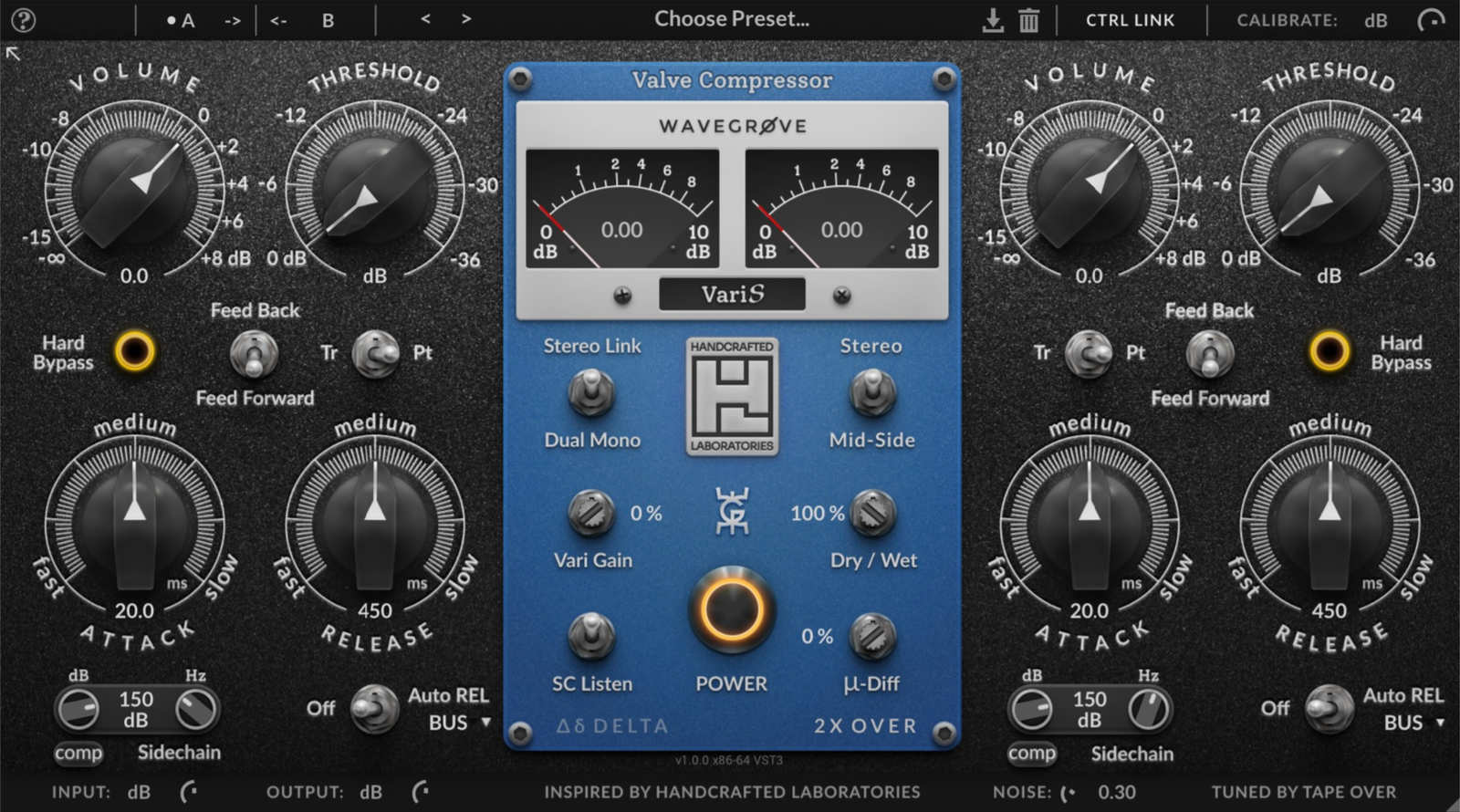REQ: Wavegrove HCL Varis v1.0.4

Wavegrove x Handcrafted Labs x Tape Over
HCL Varis is a mastering grade all tube point-to-point design vari-mu compressor. It includes feedback and feed forward modes, dual-mono, mid-side and stereo link operation, independent pentode / triode signal chain, a sidechain circuit, Edcor input transformers and Carnhill output transformers.
Varis can be found in numerous studios around the globe and Gena has done amazing upgrades to the first Varis, which was released over a decade ago.
Varis is a modern classic. Or it should be, and we’re not the only ones saying this.
Varis is a versatile and extremely flexible unit that easily covers everything you would ever want a compressor to do. Varis is basically four different compressors all packed together for pure tube action – now inside of your DAW.
VARIS TECH DETAILS
Varis is a mastering grade all tube point-to-point design vari-mu compressor. It includes feedback and feed forward modes, dual-mono, mid-side and stereo link operation, independent pentode / triode signal chains, sidechain circuit, Edcor input and Carnhill output transformers.
Compressor features Additional features
Stereo and Mid-side modes, Linking or Dual Mono.
Volume and separate Wet Blend.
Pentode / Triode circuit
Vari gain emphasis mode
mu-Differential reaction and air circuit
Threshold to control where the compressor starts to react.
Attack from 0.2 ms to 40 ms.
Release from 100 ms to 2000 ms.
As everything isn’t completely linear, we include a Level Calibration from -24 to +24 dBFS.
Control linking to allow you to control both sides of the compressor with just one set of movements.
Delta monitoring to let you hear the change from the original signal.
Oversampling to allow you to get the smoothest operation at the cost of a bit of performance.
A total of 32 Presets by TTLangen, bManic and Wavegrove
VU meters to gauge your compression.
Variable Side Chaining from 10 to 1800 Hz, with compensation.
There are switches for the Pentode and the Triode tube selection and they play a big role in this unit.
Triode can be described to be more open and tighter, while Pentode is darker and wider.
But when you switch between two compression modes, which are Feed-forward and Feed-Back, it yet again makes a difference between selected modes and impacts the sound and the behaviour of the plugin. FF mode is more complex and exciting, while FB is more predictable in its behaviour. You can blend in different variations between the selected modes and find the right tone for your source material.
PT and TR mode have also different eq-curves that are modeled from the hardware. Tonality and the differencies between the two modes can be heard when compressing at higher levels and they are also injunction with Vari gain.
With tube units, calibration and impedance is everything. While we didn’t want to model the unit 1:1, we wanted to respect these principles in our design and implement the idea so that everything reacts to the feeded gain load.
Adjusting input and output gain creates huge tonal differences in sound and impacts the behaviour of Varis. From dark hifi tone to a beautiful saturation, you have many possibilities to fine tune the behaviour by using the input and output section combined with level calibration, threshold and Vari gain.
Vari gain is an overdrive circuit that creates saturation after the compression, and partly based on the compression. Vari gain is highly gain dependent and it reacts to the signal load and reduction.
MuDiff is a variable tied to the compressor’s reaction differential, meaning its compression doesn’t simply react to the volume, but how it’s interpreted over time. It also controls an active shelf, that can reduce the loss of high frequencies when the compression is over 5dB’s. Tubes are often considered ”dark” and leveraging muDiff allows you to control how much you want to tame or excite your material.
On the bottom of the plugin you can find the INPUT and OUTPUT gains. Use them in conjunction with the other sections of the plugin to drive the stages in different ways, overdriving, or cleaning up the affected signal. The Input gain is before any processing happens, so it is as if your signal just got louder. The output gain on the other hand is after everything, even the clipper, and therefore lets you calm down the LUFS, while keeping all the distortion you were after. They can truly make or break the sound, both being something you might hope for.
The wide range dynamic Sidechain listen mode can be used intuitively to find and remove pressure points, or focus the compression to a specific area based on the selection. This helps to pin point the amount of compression to the selected area when pushing, or in releasing the energy content when gaining down. The Sidechain circuit also has gain compensation that makes the sidechain more of a tilt EQ.
Please note when using the Dynamic sidechain listen mode that the level can be increased by +12dB, if you’re using the full range decibel scale. This will also cause a shift in volume based on your monitoring levels. Wavegrove and other parties involved are not liable for any possible damages or other misuse of the product.
